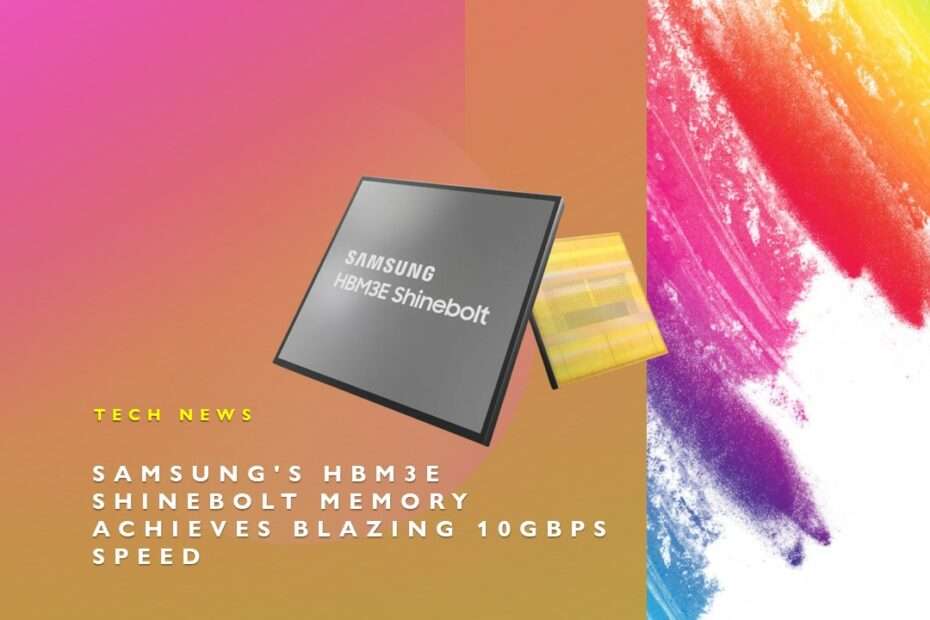At its annual Memory Tech Day event, Samsung unveiled two groundbreaking memory products, among them the next-generation HBM3E (High Bandwidth Memory 3 Extended) DRAM, known as Shinebolt. Despite arriving slightly later to the market compared to competitors like SK Hynix and Micron, who have already launched their HBM3E offerings to partners, Samsung has compensated for this delay by delivering enhanced performance.
Samsung’s Shinebolt HBM3E memory boasts impressive improvements in speed and capabilities, making it a noteworthy contender in the memory product landscape. While competitors may have had a head start, Samsung’s commitment to innovation is evident in the strides they’ve made with Shinebolt.
SK Hynix and Micron have already made significant strides in the HBM3E memory market, with SK Hynix achieving 8Gbps per pin and Micron pushing the limits with up to 9.2Gbps per pin, as reported by Hot Hardware. However, Samsung’s Shinebolt takes the lead with its remarkable 9.8 gigabits per second per pin speed. This superior performance enables Shinebolt to achieve exceptional transfer rates, surpassing the impressive milestone of more than 1.2 terabytes per second (TBps).
Samsung’s Shinebolt HBM3E memory sets a new benchmark in memory technology, promising to deliver unprecedented speed and efficiency, which could have significant implications for a wide range of applications, from high-performance computing to data-intensive tasks, setting a new standard for memory performance in the industry.
The company’s innovative approach has enabled the elimination of gaps between chip layers, resulting in improved thermal conductivity. This breakthrough not only enhances the overall performance of their memory products but also addresses concerns related to heat management. By optimizing NCF technology, Samsung has not only achieved a more compact and efficient design but has also significantly improved the heat characteristics of their memory solutions, ensuring reliability and longevity for a variety of applications.
Shinebolt, Samsung’s groundbreaking HBM3E memory, has reached a significant milestone by entering mass production, with samples already being shipped to customers. This development marks a significant step forward in the availability and accessibility of this high-performance memory solution. The immediate availability of samples demonstrates Samsung’s commitment to meeting the demands of the tech industry. These initial shipments are poised to play a pivotal role in enhancing AI-model training within data centers, potentially revolutionizing the capabilities of data-intensive tasks by providing the necessary speed and performance.
Samsung’s innovation extends beyond the realm of high-speed HBM3E memory, as the company also introduced its GDDR7 product, heralded as the industry’s inaugural offering with a remarkable speed of 32Gbps. This new GDDR7 memory represents a significant leap forward from its predecessor, GDDR6, which initially debuted on Nvidia’s GeForce 20 series cards in 2018. While GDDR6X made incremental speed improvements with the RTX 30 Series, it’s worth noting that the technology is now more than three years old, signaling the need for an upgrade to meet the evolving demands of the tech industry.

Samsung’s introduction of GDDR7 paves the way for faster and more capable graphics memory, promising improved performance in a range of applications, from gaming to high-performance computing. This advancement signifies Samsung’s ongoing commitment to staying at the forefront of memory technology and ensuring that consumers and industries have access to cutting-edge solutions that push the boundaries of what’s possible in the world of graphics and data processing.
Samsung’s latest GDDR7 memory offering comes with notable advantages in terms of energy efficiency and performance. The company has stated that GDDR7 is expected to be around 20 percent more energy-efficient than its predecessor, GDDR6, making it a compelling choice for applications where power consumption is a significant concern. Additionally, Samsung has introduced a low operating voltage option, catering to the needs of applications that prioritize power usage and aim for a balance between performance and energy efficiency.
Furthermore, the GDDR7 memory stands out for its remarkable bandwidth capabilities, reaching up to 1.5 terabytes per second (TBps). This achievement is partly attributed to the implementation of Pulse Amplitude Modulation (PAM3) signaling, a more advanced technique compared to the older Non Return to Zero (NRZ) method. This advancement underscores Samsung’s dedication to pushing the boundaries of memory technology, offering solutions that not only deliver impressive speed but also address energy efficiency, making it a valuable choice for a wide range of applications across various industries.
Maybe you liked other articles too?

